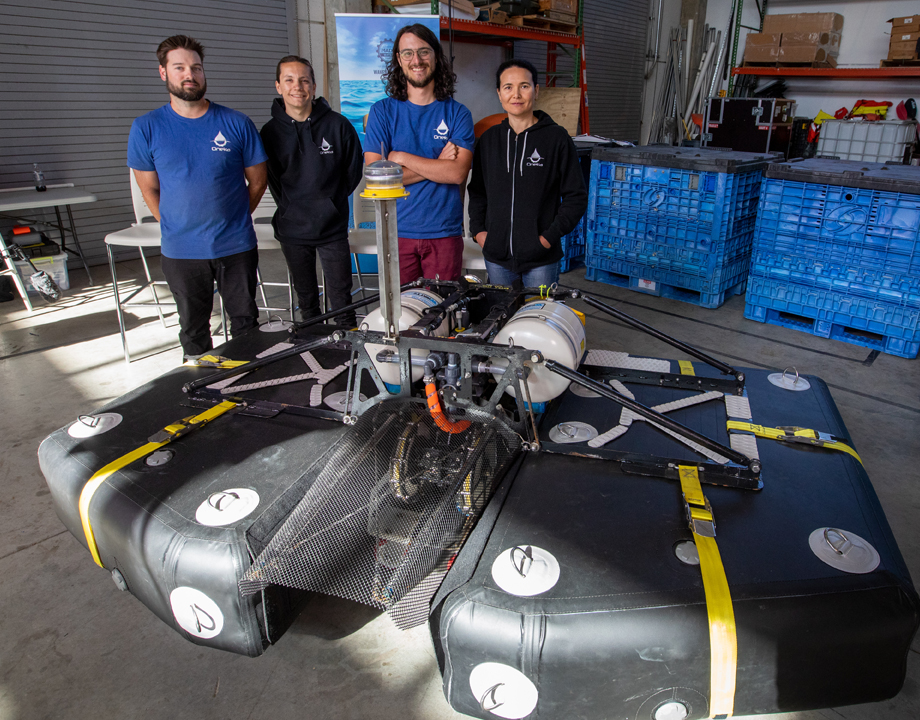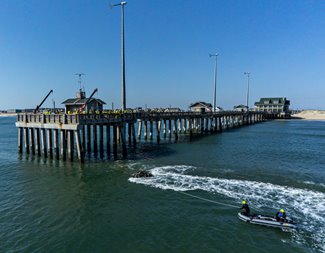A Wave-Powered Desalination Competition Advances Feasible Technologies
A Wave-Powered Desalination Competition Advances Feasible Technologies


The winner, Oneka Technologies, produced a wave-powered reverse osmosis system that can generate 265 gallons of water a day. Photo: U.S. Department of Energy
After three years and an unpredictable finale, the U.S. Department of Energy Waves to Water competition is complete, with Quebec-based Oneka Technologies going home with the $500,000 grand prize. The contest challenged participants to present compact wave-powered desalination systems, a request that teams met by fine-tuning existing technology or building new models from scratch.
The final wave-powered desalination systems were effective enough that the Water Power Technologies Office emphasized the near-term value of the technology in a recent budget request, said Jennifer Garson, office director.
“If we can develop the technologies necessary to equip communities or disaster relief organizations with wave-powered desalination as a viable option for the production of potable water, that's a pretty exciting opportunity,” Garson said.
As part of the American Made Challenges, Waves to Water was a competition-based clean energy innovation program hosted by the Department of Energy. For this competition, the DOE was interested in promoting wave energy commercialization for a setting outside the traditional power grid, Garson said.
More specifically, the agency centered the competition around emergency relief. When hurricanes and other disasters break down water infrastructure, the stopgap is typically pallets of water bottles, Garson said.
If a community sets up emergency desalination instead, it often requires diesel for an energy-intensive process known as reverse osmosis. The technique relies on 800 to 1,000 pounds per square inch to push water through filtering membranes. Instead of turning to tanks of fossil fuels, disaster areas could theoretically rely on clean energy coming from the same ocean as the areas’ drinking water.
More for You: 8 Engineering Challenges for Desalination Technologies
To foster feasible disaster zone technologies, contestants had to operate with real-world constraints. The products had to fit on a shipping container and into a Toyota Hilux, one of the top-selling cars in the world, as well as take less than 48 hours to set up. Contestants also had to go through conceptual, model, and real-world prototype contest phases.
For the competition, the National Renewable Energy Laboratory (NREL), an arm of the Department of Energy, received support from Engineering for Change (E4C) through its Impact Services effort. E4C staff and affiliated experts provided training to the competitors and supported the planning of future prizes. Additionally, it completed a market assessment of opportunities and barriers for wave energy-powered desalination systems to support commercialization efforts through engagement with organizations and end-users in key market categories, such as disaster relief, industrial, and municipal water supplies.
The final piece of the competition played out in April when the five remaining participants launched their technology off the coast of Nags Head, N.C. Smaller prizes went to contestants Water Bros, MarkZero Prototypes, and Project 816, which won money in categories like lightest shipping weight, simplest assembly, and simplest deployment. The largest award went to Snowflake, the system Oneka Technologies designed and produced.
The seven year-old company was founded to offer a range of wave-powered desalination systems for commercial use. Snowflake, renamed as IceCube for commerical use, is its smallest option, and essentially packs the standard company desalination technology into a smaller frame, said Dragan Tutic, Oneka CEO and co-founder.
The Snowflake buoy, anchored to the sea floor, sits on the waves and converts the motion of the water into usable energy while filling an internal water tank. When the waves rise, the buoy pressurizes the water and pushes it ashore via tubes running onto land, where the water is further pressurized to go through reverse osmosis. The entire system—which is about five and a half feet wide and eight and a half feet across once inflated—puts out 265 gallons of water per day, depending on wave height.
Most Snowflake pieces come from standard hardware stores and the desalination system comes with backup parts for the pressurizing components that people in disaster areas might struggle to find. These aspects of the Snowflake design come from Oneka having gathered some of its own information about real-world disaster needs: The team ran trial deployments in Florida, and members also spoke with water.org for the nonprofit’s perspective, Tutic said.
Reader's Choice: Solar Desalination System Delivers High Energy Outut
Though design durability wasn’t part of the entry requirements, Oneka and the other teams demonstrated how well their products handled rough seas in April. After only eight hours of operating time, an unexpected storm tore every device from its moorings. Oneka and the other contenders rescued their designs from under piers, but the experience served as a good reminder of what conditions crop up at sea, Tutic said. “There’s some magical things that happen in the ocean.”
Other participants walked away with different lessons. MarkZero Prototypes, a Connecticut-based startup, expressed interest in marinizing valves and other equipment to make them more durable in the corrosive conditions. Garson mentioned that one professor affiliated with Water Bros, a partnership that at the time of the contest included North Carolina State University and the University of North Carolina at Charlotte researchers, said he plans to put more hands-on experiences into his teaching.
NREL employees found the deployments helpful for understanding their own desalination system. The lab tested its prototype in the same Nags Head coastal waters before the competition and plans to release an open-source version of assembly and operations instructions, Garson said.
Ultimately, NREL wants to make wave-powered desalination systems a real possibility for more communities, something Tutic thinks North American communities sometimes forget they might need.
“We need to find more long-term solutions for the water supply,” Tutic said. “If we wait too long and don’t find new ways to desalinate sustainably, then we’ll be stuck where we have to build things fast that are even more unsustainable and ironically, compromise the future even more.”
Leslie Nemo is an independent writer in Brooklyn, N.Y.
The final wave-powered desalination systems were effective enough that the Water Power Technologies Office emphasized the near-term value of the technology in a recent budget request, said Jennifer Garson, office director.
“If we can develop the technologies necessary to equip communities or disaster relief organizations with wave-powered desalination as a viable option for the production of potable water, that's a pretty exciting opportunity,” Garson said.
As part of the American Made Challenges, Waves to Water was a competition-based clean energy innovation program hosted by the Department of Energy. For this competition, the DOE was interested in promoting wave energy commercialization for a setting outside the traditional power grid, Garson said.
More specifically, the agency centered the competition around emergency relief. When hurricanes and other disasters break down water infrastructure, the stopgap is typically pallets of water bottles, Garson said.
If a community sets up emergency desalination instead, it often requires diesel for an energy-intensive process known as reverse osmosis. The technique relies on 800 to 1,000 pounds per square inch to push water through filtering membranes. Instead of turning to tanks of fossil fuels, disaster areas could theoretically rely on clean energy coming from the same ocean as the areas’ drinking water.
More for You: 8 Engineering Challenges for Desalination Technologies
To foster feasible disaster zone technologies, contestants had to operate with real-world constraints. The products had to fit on a shipping container and into a Toyota Hilux, one of the top-selling cars in the world, as well as take less than 48 hours to set up. Contestants also had to go through conceptual, model, and real-world prototype contest phases.
For the competition, the National Renewable Energy Laboratory (NREL), an arm of the Department of Energy, received support from Engineering for Change (E4C) through its Impact Services effort. E4C staff and affiliated experts provided training to the competitors and supported the planning of future prizes. Additionally, it completed a market assessment of opportunities and barriers for wave energy-powered desalination systems to support commercialization efforts through engagement with organizations and end-users in key market categories, such as disaster relief, industrial, and municipal water supplies.
Final Competition
The final piece of the competition played out in April when the five remaining participants launched their technology off the coast of Nags Head, N.C. Smaller prizes went to contestants Water Bros, MarkZero Prototypes, and Project 816, which won money in categories like lightest shipping weight, simplest assembly, and simplest deployment. The largest award went to Snowflake, the system Oneka Technologies designed and produced.
The seven year-old company was founded to offer a range of wave-powered desalination systems for commercial use. Snowflake, renamed as IceCube for commerical use, is its smallest option, and essentially packs the standard company desalination technology into a smaller frame, said Dragan Tutic, Oneka CEO and co-founder.
The Snowflake buoy, anchored to the sea floor, sits on the waves and converts the motion of the water into usable energy while filling an internal water tank. When the waves rise, the buoy pressurizes the water and pushes it ashore via tubes running onto land, where the water is further pressurized to go through reverse osmosis. The entire system—which is about five and a half feet wide and eight and a half feet across once inflated—puts out 265 gallons of water per day, depending on wave height.
Most Snowflake pieces come from standard hardware stores and the desalination system comes with backup parts for the pressurizing components that people in disaster areas might struggle to find. These aspects of the Snowflake design come from Oneka having gathered some of its own information about real-world disaster needs: The team ran trial deployments in Florida, and members also spoke with water.org for the nonprofit’s perspective, Tutic said.
Reader's Choice: Solar Desalination System Delivers High Energy Outut
Though design durability wasn’t part of the entry requirements, Oneka and the other teams demonstrated how well their products handled rough seas in April. After only eight hours of operating time, an unexpected storm tore every device from its moorings. Oneka and the other contenders rescued their designs from under piers, but the experience served as a good reminder of what conditions crop up at sea, Tutic said. “There’s some magical things that happen in the ocean.”
Other participants walked away with different lessons. MarkZero Prototypes, a Connecticut-based startup, expressed interest in marinizing valves and other equipment to make them more durable in the corrosive conditions. Garson mentioned that one professor affiliated with Water Bros, a partnership that at the time of the contest included North Carolina State University and the University of North Carolina at Charlotte researchers, said he plans to put more hands-on experiences into his teaching.
NREL employees found the deployments helpful for understanding their own desalination system. The lab tested its prototype in the same Nags Head coastal waters before the competition and plans to release an open-source version of assembly and operations instructions, Garson said.
Ultimately, NREL wants to make wave-powered desalination systems a real possibility for more communities, something Tutic thinks North American communities sometimes forget they might need.
“We need to find more long-term solutions for the water supply,” Tutic said. “If we wait too long and don’t find new ways to desalinate sustainably, then we’ll be stuck where we have to build things fast that are even more unsustainable and ironically, compromise the future even more.”
Leslie Nemo is an independent writer in Brooklyn, N.Y.






